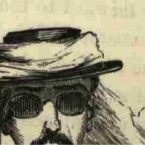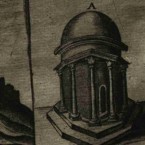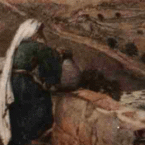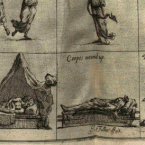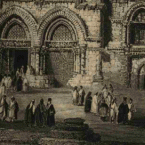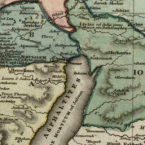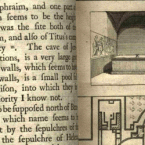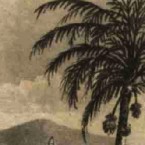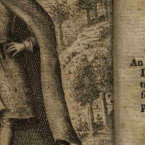Mobile Subjects
This case peers into the relationship between person and place to investigate topics that mingle and identities that make excursions as these books visit Palestine. Pilgrimage changes into modern sightseeing, and subjects discover their situation as they journey over topography and topics, and through the threats and appeals travel poses to knowledge and identity. Just as books mobilize authors’ subjectivities and perspectives, the subjects these books create shift as their authors and readers move.
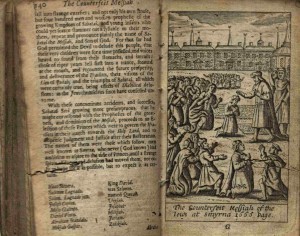 There are only two illustrations in this tiny and exceedingly worn compilation of memoir and religious writing, neither of which are of Palestine. They both however, depict people enacting events in Jewish history, and their almost naïve representations of space, and their hobblingly symmetrical composition ally them closely with an ornamental rather than informative
There are only two illustrations in this tiny and exceedingly worn compilation of memoir and religious writing, neither of which are of Palestine. They both however, depict people enacting events in Jewish history, and their almost naïve representations of space, and their hobblingly symmetrical composition ally them closely with an ornamental rather than informative 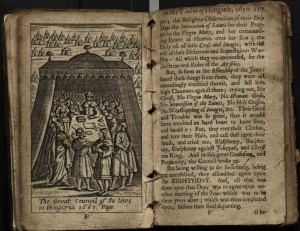 tradition of illustration. Jewishness, here, is an exotic place charact-erized by actors, and “foreign” enough to be worth seeing through an illustrated window in even this tiny and cheap book—whose wear suggests that its value as diversion was greater than its material cost. This well-travelled travel book is a reminder that Jerusalem may be carried about as an idea, as a place bouncing between empires, states and peoples, but also as a book.
tradition of illustration. Jewishness, here, is an exotic place charact-erized by actors, and “foreign” enough to be worth seeing through an illustrated window in even this tiny and cheap book—whose wear suggests that its value as diversion was greater than its material cost. This well-travelled travel book is a reminder that Jerusalem may be carried about as an idea, as a place bouncing between empires, states and peoples, but also as a book.
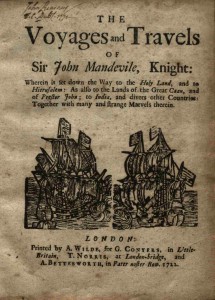 One of the most famous travel
One of the most famous travel 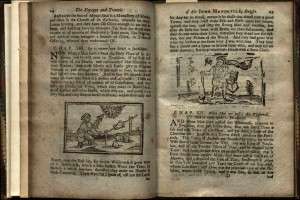
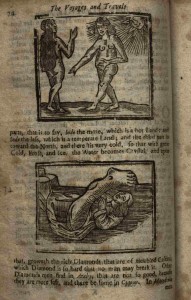 accounts of all time, Sir John Mandeville’s medieval narrative originated when stories could be as useful to travelers as maps, and widespread copying could spread the voice of an authorial identity without authority. Depending on the reader, this 1722 reprint could have been interpreted either as a commercial reissuing of a fictional work, or as a historical but still accurate travel account. The relatively inexpert stock wood-cut illustrations in this edition embellish the text, but correspond only tangentially to the text, and so were probably not cut for this particular work. This cost-cutting measure matches the relatively poor print quality of this edition as a whole: as a publication it seems intended to entertain rather than dazzle its reader. The illustrations act as visual encouragements to the imagination, incitements to engage the reader and prompt her mental excursions, rather than as detailed representations of the landscapes in question.
accounts of all time, Sir John Mandeville’s medieval narrative originated when stories could be as useful to travelers as maps, and widespread copying could spread the voice of an authorial identity without authority. Depending on the reader, this 1722 reprint could have been interpreted either as a commercial reissuing of a fictional work, or as a historical but still accurate travel account. The relatively inexpert stock wood-cut illustrations in this edition embellish the text, but correspond only tangentially to the text, and so were probably not cut for this particular work. This cost-cutting measure matches the relatively poor print quality of this edition as a whole: as a publication it seems intended to entertain rather than dazzle its reader. The illustrations act as visual encouragements to the imagination, incitements to engage the reader and prompt her mental excursions, rather than as detailed representations of the landscapes in question.
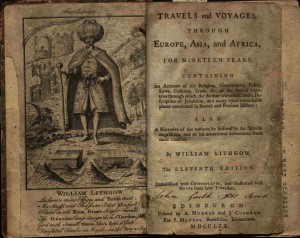 This book resists inclusion in my catalogue since it neither contains illustrations of Palestine, nor was printed in London. Its frontispiece illustration, however, begs inclusion because of its indication of the complicated framing of the traveling subject in this period. This kind of exoticization of a metropole subject bespeaks a political definition of the traveling national subject as costumed, and disguisable: the journey literally begins in the wardrobe, and in the route down a sleeve or pantleg, as much as over the Channel. This identification of the body of the traveler with the projected identities of the people inhabiting the places he visits is extended in the unity the author draws between books and persons. “Judicious lector,” he writes in a Prologue to the Reader, “If good books may be termed wise guides, then certainly true histories may be termed perfect oracles, secret councellors, private schoolmasters, familiar friends to cherish knowledge.” He goes on to combine his own person with the body of his book: “This laborious work then of mine, depending on this preamble is only composed of mine own eyesight and ocular experience (pluris est oculatus testis unus quam auriti decem) being the perfect mirror, and lively portraiture of true understanding.” His description of his ultimate departure from the Holy Land is equally revealing of his association of vision, knowledge, and mastery: “I took leave of this now seen country, with a greedy conceit of more curiosities” (280, emphasis added).
This book resists inclusion in my catalogue since it neither contains illustrations of Palestine, nor was printed in London. Its frontispiece illustration, however, begs inclusion because of its indication of the complicated framing of the traveling subject in this period. This kind of exoticization of a metropole subject bespeaks a political definition of the traveling national subject as costumed, and disguisable: the journey literally begins in the wardrobe, and in the route down a sleeve or pantleg, as much as over the Channel. This identification of the body of the traveler with the projected identities of the people inhabiting the places he visits is extended in the unity the author draws between books and persons. “Judicious lector,” he writes in a Prologue to the Reader, “If good books may be termed wise guides, then certainly true histories may be termed perfect oracles, secret councellors, private schoolmasters, familiar friends to cherish knowledge.” He goes on to combine his own person with the body of his book: “This laborious work then of mine, depending on this preamble is only composed of mine own eyesight and ocular experience (pluris est oculatus testis unus quam auriti decem) being the perfect mirror, and lively portraiture of true understanding.” His description of his ultimate departure from the Holy Land is equally revealing of his association of vision, knowledge, and mastery: “I took leave of this now seen country, with a greedy conceit of more curiosities” (280, emphasis added).
This nicely bound book with a gold-embossed spine contains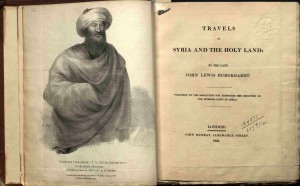 a large and stunningly detailed fold-out map of Palestine. By far the most striking, and to modern sensibilities, odd, of the illustrations in this book, however, is the frontispiece portrait of the author, identified as follows: “Skeikh Ibrahim (I. L. Burckhardt)” in his Arab Bernous /Sketched at Cairo in Feb 1817 by H. Salt.” Authorial trustworthiness here is consolidated by “looking authentic”
a large and stunningly detailed fold-out map of Palestine. By far the most striking, and to modern sensibilities, odd, of the illustrations in this book, however, is the frontispiece portrait of the author, identified as follows: “Skeikh Ibrahim (I. L. Burckhardt)” in his Arab Bernous /Sketched at Cairo in Feb 1817 by H. Salt.” Authorial trustworthiness here is consolidated by “looking authentic”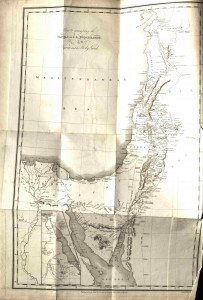 according to a metropole vision of what a subject of one of the places he visits might look like. Costumes make national identity, while authority is a visible, and self-consciously performable characteristic, especially if corroborated by a pseudonym—in this case the temporary replacement of I. L. Burckhardt with Skeikh Ibrahim. This semblance of authenticity is further enhanced by the declaration that this highly authentic portrait of the author “going Native,” as it were, was sketched in Cairo, effectively “shot on location,” as twentieth-century film credits would declare. The locatability of the performed transnational authorial subject contributes to his claims of having “really” been far afield, and so authorized to write a worthwhile book on the topic. Since the technique of engraving entails a re-drawing of any given image into metal, however, whatever precision and detail the image gained from being drawn on Egyptian soil has had a high risk of being lost in visual translation. Nevertheless, it is this history of ascribing precise and true locations to scenes identified in proliferating and mass produced images that allowed photographic and later cinematic images to claim to be or at least represent real and currently actual places.
according to a metropole vision of what a subject of one of the places he visits might look like. Costumes make national identity, while authority is a visible, and self-consciously performable characteristic, especially if corroborated by a pseudonym—in this case the temporary replacement of I. L. Burckhardt with Skeikh Ibrahim. This semblance of authenticity is further enhanced by the declaration that this highly authentic portrait of the author “going Native,” as it were, was sketched in Cairo, effectively “shot on location,” as twentieth-century film credits would declare. The locatability of the performed transnational authorial subject contributes to his claims of having “really” been far afield, and so authorized to write a worthwhile book on the topic. Since the technique of engraving entails a re-drawing of any given image into metal, however, whatever precision and detail the image gained from being drawn on Egyptian soil has had a high risk of being lost in visual translation. Nevertheless, it is this history of ascribing precise and true locations to scenes identified in proliferating and mass produced images that allowed photographic and later cinematic images to claim to be or at least represent real and currently actual places.
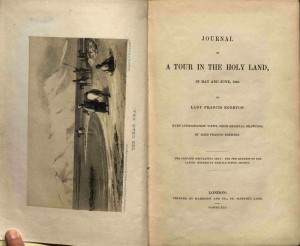 This work represents several
This work represents several 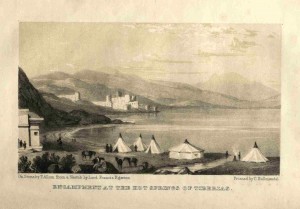 gendered excursions: though it was printed in London, this book was issued to benefit the Hibernian Female School Society, and is noteworthy both for its female author, and as a relatively early example of lithographic travel illustration. Curiously for this study
gendered excursions: though it was printed in London, this book was issued to benefit the Hibernian Female School Society, and is noteworthy both for its female author, and as a relatively early example of lithographic travel illustration. Curiously for this study 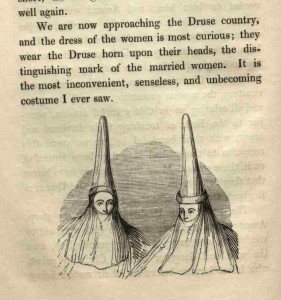 of the relation between visual epistemology and landscape, when writing of the Palestinian Druse minority Egerton notes that “the dress of the women is more curious […] it is the most inconvenient, senseless and unbecoming costume I ever saw” (78). Egerton’s avowal that the women’s habits—a term used advisedly here for its connotations of home, practice, and costume—are both “curious” and “senseless” shows the friction between incitements to and refusals of knowledge in encounters between traveling subjects and inhabitants of the landscapes they visit.
of the relation between visual epistemology and landscape, when writing of the Palestinian Druse minority Egerton notes that “the dress of the women is more curious […] it is the most inconvenient, senseless and unbecoming costume I ever saw” (78). Egerton’s avowal that the women’s habits—a term used advisedly here for its connotations of home, practice, and costume—are both “curious” and “senseless” shows the friction between incitements to and refusals of knowledge in encounters between traveling subjects and inhabitants of the landscapes they visit.
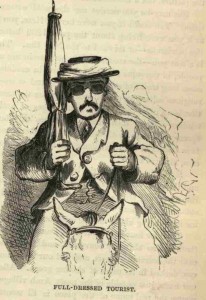 Mark Twain’s The Innocents Abroad
Mark Twain’s The Innocents Abroad 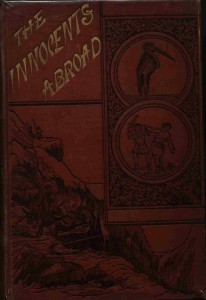 contains a long-popular account
contains a long-popular account
of the region under Ottoman rule in the late-nineteenth century that is replete with the author’s characteristically pungent witticisms. The mocking illustration of the “full-dressed tourist” indicates the extent to which tourism was already clichéd by the 1880s. Though it was originally published in New York, this London edition includes a few anonymous decorative illustrations, and, most curiously, a font inspired by 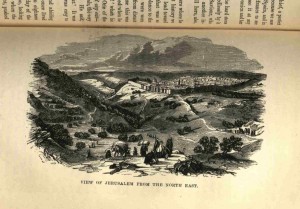 Chinese characters embossed on its cover. In a moment of casebook Orientalism, Eastern exoticisms are combined indiscriminately in the thinking the visual system of this book expresses.
Chinese characters embossed on its cover. In a moment of casebook Orientalism, Eastern exoticisms are combined indiscriminately in the thinking the visual system of this book expresses.
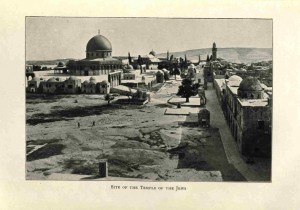
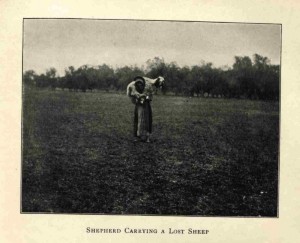 Haggard’s account of his “Winter Pilgrimage” is the only work in this collection to include photographs, which are referred to throughout as “illustrations.” As with Bartlett’s depiction of Arabs as architecture, Haggard’s captions sometimes enact spurious vanishings of what his images ostensibly portray: for example, an image of
Haggard’s account of his “Winter Pilgrimage” is the only work in this collection to include photographs, which are referred to throughout as “illustrations.” As with Bartlett’s depiction of Arabs as architecture, Haggard’s captions sometimes enact spurious vanishings of what his images ostensibly portray: for example, an image of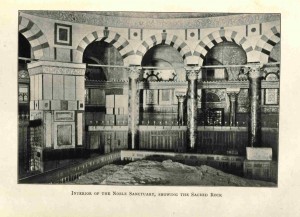 four Arab
four Arab 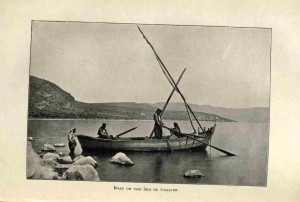 men in a boat is labeled as “Boat on the Sea of Galilee,” rather than “boaters.” Meanwhile, a stagey photograph captioned
men in a boat is labeled as “Boat on the Sea of Galilee,” rather than “boaters.” Meanwhile, a stagey photograph captioned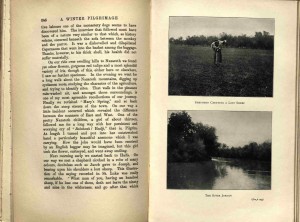 “shepherd carrying lost sheep” depicts a longing for a Palestine inscribed with Jesus’s famous
“shepherd carrying lost sheep” depicts a longing for a Palestine inscribed with Jesus’s famous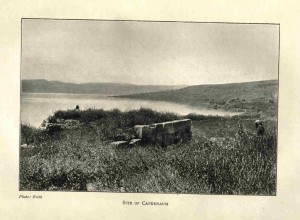 acts and symbolism. This luxury edition has red and black title page typography, a moment of bibliographic nostalgia that either belies or lends authority to its photographs.
acts and symbolism. This luxury edition has red and black title page typography, a moment of bibliographic nostalgia that either belies or lends authority to its photographs.
Next Display Case: Perspectives on Jerusalem
